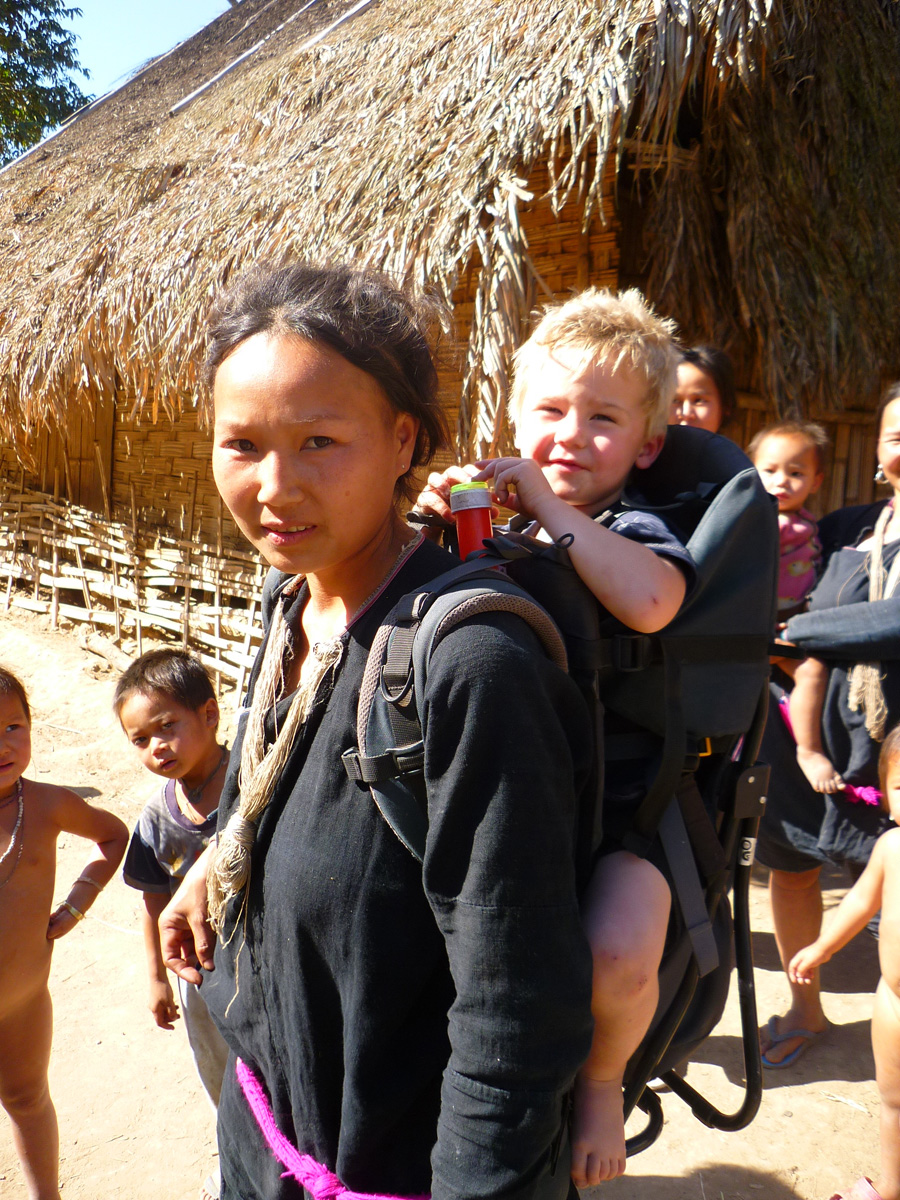Luang Namtha Province, Northern Laos
Jan 27th – 31st

Half a dozen kilometers outside of the town of Luang Nam Tha in northern Laos, Oliver stood in the patchy light that pricked through the rattan thatch roof of a Lenten communal hut and was surrounded by more than twenty of the village children. Some of them gawked in disbelief at the straw-haired ragamuffin in their midst, perhaps incredulous that such an impossibly tall baby appeared to have so much trouble standing still. Others giggled each time he tripped over his own two feet, literally falling victim to his long, wobbly legs and oversized, knobby knees. A cluster of mothers, barely more than girls themselves, slapped their thighs and howled with laughter, and occasionally one stepped forward to affectionately brush Ollie’s cheek. They spoke an ancient Tibeto-Burman dialect that was entirely different from the bits of Lao I’d managed to decipher in the market.
Ryan finally interrupted our son’s slapstick routine to pass an apple that had been stashed away in our daypack. I followed his lead and seized the opportunity to make this a teachable moment.
“Hey, Ol, that little guy over there looks like he would really like a bite of your apple. Why don’t you go over and share with him?”
And so Oliver proceeded around the room with an outstretched arm and a partially munched piece of fruit. When approached, some of the kids retreated to the indigo-dyed folds of their mother’s tunics, but a handful of the older children stepped forward to look Ollie squarely in the eye. To the smallest child, a little girl of barely more than a year, Ollie squatted on his haunches and cocked his head quizzically.
“You wanna bite ah dis apple?”
In a few moments, he was off again, dashing past the old pot-bellied sow and her trio of piglets rooting around in the dirt outside, and right through a mother hen’s brood of molting adolescent chicks. When I finally emerged from the hut, I found him clear across the village at the foot of a small hill, again surrounded by more than half the inhabitants. This time, he was stark naked and swirling around like a dervish in an enormous mud puddle that most likely belonged to the aforementioned family of pigs.
The ensuing scene was pure ‘golden-era’ stock comedy, as I chased him through and around the mud, all the while slipping on clusters of wet hay and trampled grass, barely able to keep my own balance. Lubricated by the grime, Oliver inevitably wriggled free each time I grasped an arm or a leg, and soon the entire village had gathered to watch and cheer on my effort to subdue our son’s naughtiness. I finally caught him in the end, and one of the old patriarchs nearly busted a seam as he helped pour river water from a gourd over Ollie’s head as I gave him a thorough scrubbing.
This was our third day in this famously quiet country where the pace of life proceeds as slowly and deliberately as the course of the Mekong during the dry season. Entering Laos through the northern Thai border of Huay Xia, we shied away from falling lock-step into the path of other travelers winding their way two days down the river to beckoning Luang Prabang, and instead forged north, deep into the forest.
At its heart, Laos stands starkly apart from its sophisticated neighbor to the west, Thailand. Families still squat in the dirt around a fire for their dinners as they have for centuries, and nimble-footed men from bamboo and rattan villages still ply the forest with their machetes in search of wild edibles that have no translated English names. We followed two of these men, both naturally soft-spoken H’mong, for two days through the Nam Ha wilderness. Wild-eyed and breathless, we walked for hours through a mosaic of habitats; mature evergreen forest, deciduous broadleaf woodlands, and sky-high clusters of giant bamboo that bent like the great, green arches of a mountain cathedral over our solemn heads.
The recent Chinese incursion into the north of Laos has brought new roads and construction crews to the mountain towns, and from a clearing along a ridge on our first day, we saw tremendous swathes of land where the forest had been razed and replaced by fledgling rubber tree groves, a principal raw material export. Sing, our sole English-speaking guide, explained how nearly everything pulled from the forest; be it timber, wild cardamom, or even the endangered muntjac deer, was consumed by China.
The path for the most part could scarcely be called one at all. Sing and Chi crisscrossed us through the Nam La River several times and led us steeply up the banks to an indistinguishable trail that villagers used to bisect the forest on either mountain. Very often we found ourselves negotiating mind-numbingly steep grades as our guides took us sharply up and down between the peaks. Suddenly, we were able to consider the switchback trail design of the Annapurna Circuit quite objectively, as merciful turning areas on the trail were nowhere to be found in this part of Laos. In the severest segments, carved out toe-holds beneath clumps of damp, fallen leaves and dangling vines were all that prevented us from tumbling off the side of the trail. In the face of all our efforts, our tiny Lao guides floated along the path like the vaporous mountain spirits that they worshipped, and aside from their birdcalls, they seldom made a sound.

Camp for the night was a small, open-air bamboo and banana-thatch affair at the foot of the mountain close to where the Nam La spilled off a cliff. The forest faced us from across the river and hemmed us in on our left, right and back sides. Any approach to or away from our camp required a steep climb from our little grotto up one of the surrounding mountains. As the light crept away, Sing and Chi scuttled around, procuring vegetables from the forest and mincing buffalo meat purchased from the market the prior day. Ryan and I worked to fetch shards of bamboo in an effort to build up the fire in preparation for the long, cold night that lay in front of us.
After a remarkably good dinner of laap (spicy Lao meat salad), kaeng pak (Chinese kale soup), and sticky rice, our guides stripped to their skivvies and wandered off to spear tiny river fish by flashlight. Chi spitted a frog he had caught near the waterfall, and before we tucked Ollie away in the hut for the night, all three of us tasted frog legs for the first time, roasted over an open fire.
As our guides turned in, Ryan and I walked down towards the Nam La and watched the full moon rise directly above us in a clear sky between the mountains. The small clearing where we camped was flooded in shades of blue and white and the river glittered from its clear depths where the moon caught the smooth river stones and caused them to glow. Before us, on the opposite bank, the jungle stood by darkly and heaved animal sighs as its denizens came to life.
Under layers of blankets we shivered as the temperature plummeted close to freezing. We slept in intervals, both of us regularly waking to see that Ollie was properly covered, or starting at the sound of a mouse burrowing in the banana leaves over our heads. Our sleep was buffeted by the sound of the Nam La rushing onward to where it met the Nam Tha, a tributary off the mighty Mekong.
The following morning we were fed and up the mountain before nine. The early light filtered through the jungle canopy and illuminated the dried, yellow undersides of fallen leaves strewn across our path. Tall purple flowers resembling lavender lined the trail and perfumed the air. Our guide doubled a saw palm leaf in his hand, blew across it sharply and mimicked the call of a young Sambar Deer to its mother.
Ryan took the opportunity to offload the nearly 24 kilos of Oliver and child carrier on his back at points where the path was more negotiable, and Ollie, clutching his ‘rod and staff’ (a tiny walking stick and an enormous banana leaf), didn’t hesitate to blaze a trail. It is something to see your 30 month old son run care-free through the forests of Northern Laos.

Our adventure concluded with Ollie’s antics in the Lenten village. At the end of our trek, Sing welcomed us into his home in Had Yao village to meet his wife and two little girls. Ollie was fitted in snappy H’mong attire for a photo op with the family, and again, nearly the entire village turned out to look on. Over dinner, Sing bashfully told us that we were the first foreigners he had ever welcomed into his home, and as we cooed over daughters, it was clear that he could barely conceal his pride. As the shadows grew long into the evening and the laughter of the village children floated back to us, Sing informed us that most of the surrounding villages had never seen a Western child before. I glanced up at Ollie and Ryan; Ryan tickled Ollie’s bare feet as the little guy blew raspberries in his ear. I laughed and agreed with Sing. I could be wrong, but it would be a long time before Northern Laos saw anything quite like the three of us again.


Emily, I LOVE your posts. Can't wait to see your entire adventure on paper. Miss you guys!
thanks Liz! i will certainly draw upon your fantastic example if this ever becomes something more than just a blog. we miss you, too! love to big mike and the kids.